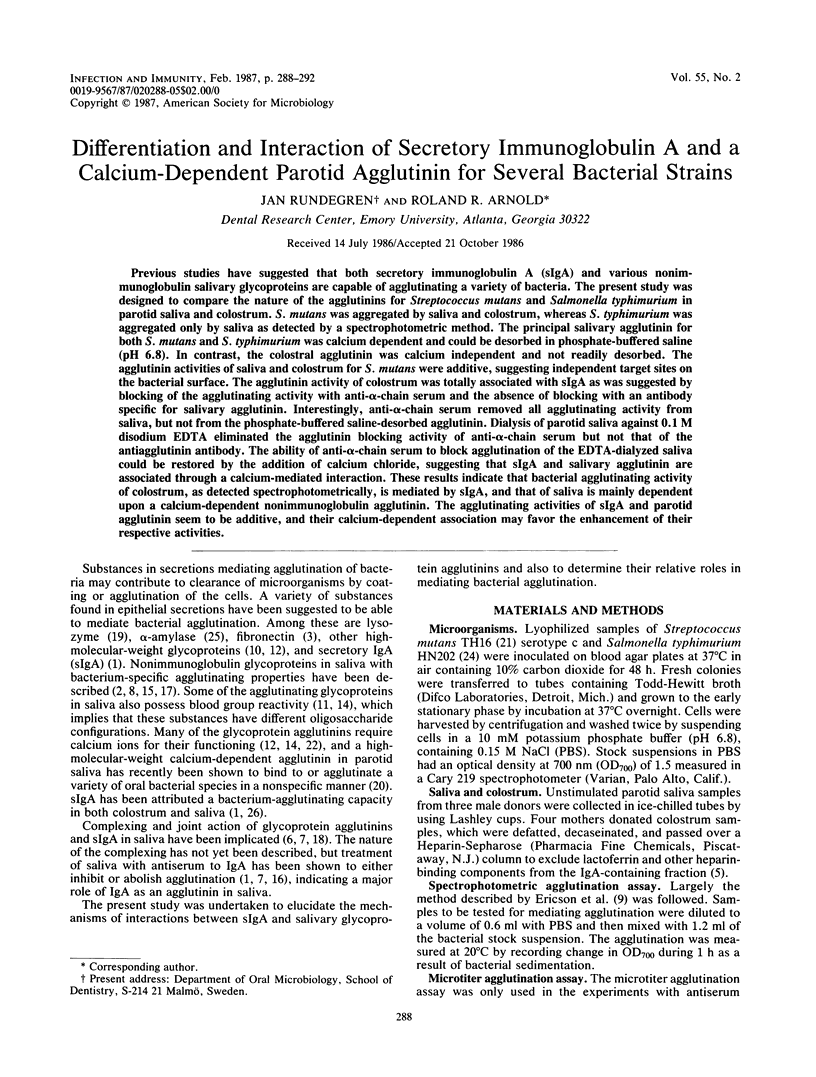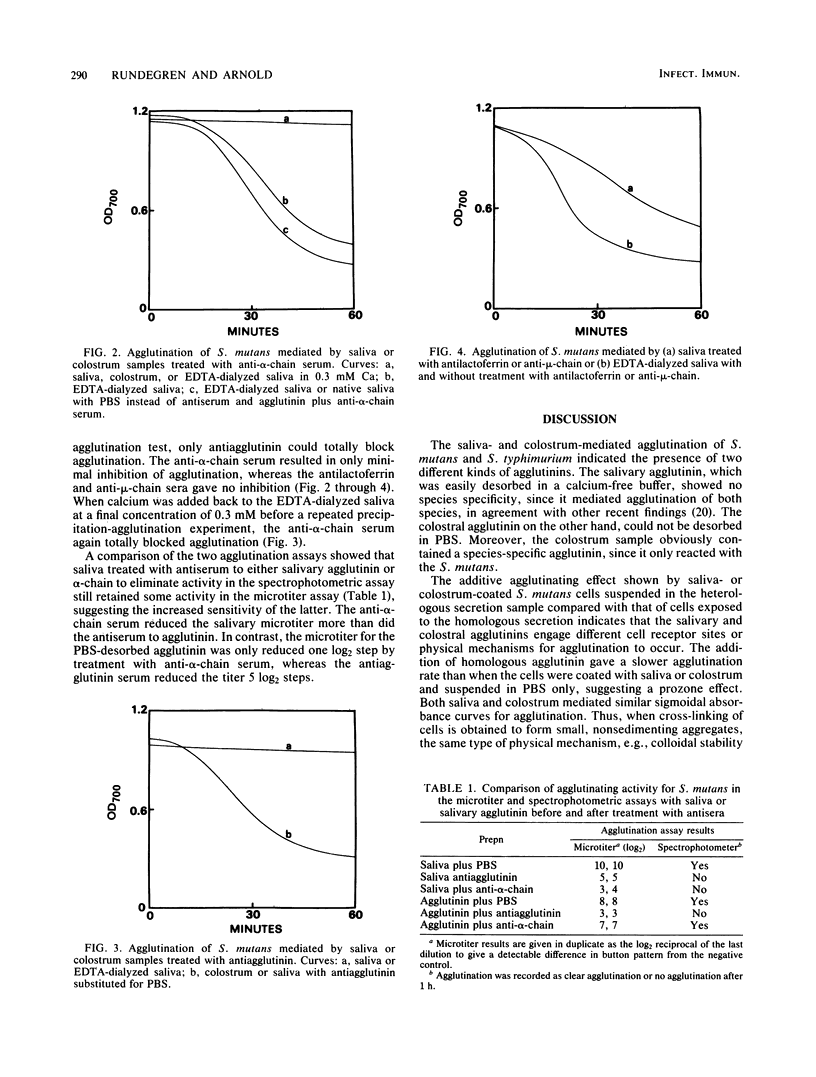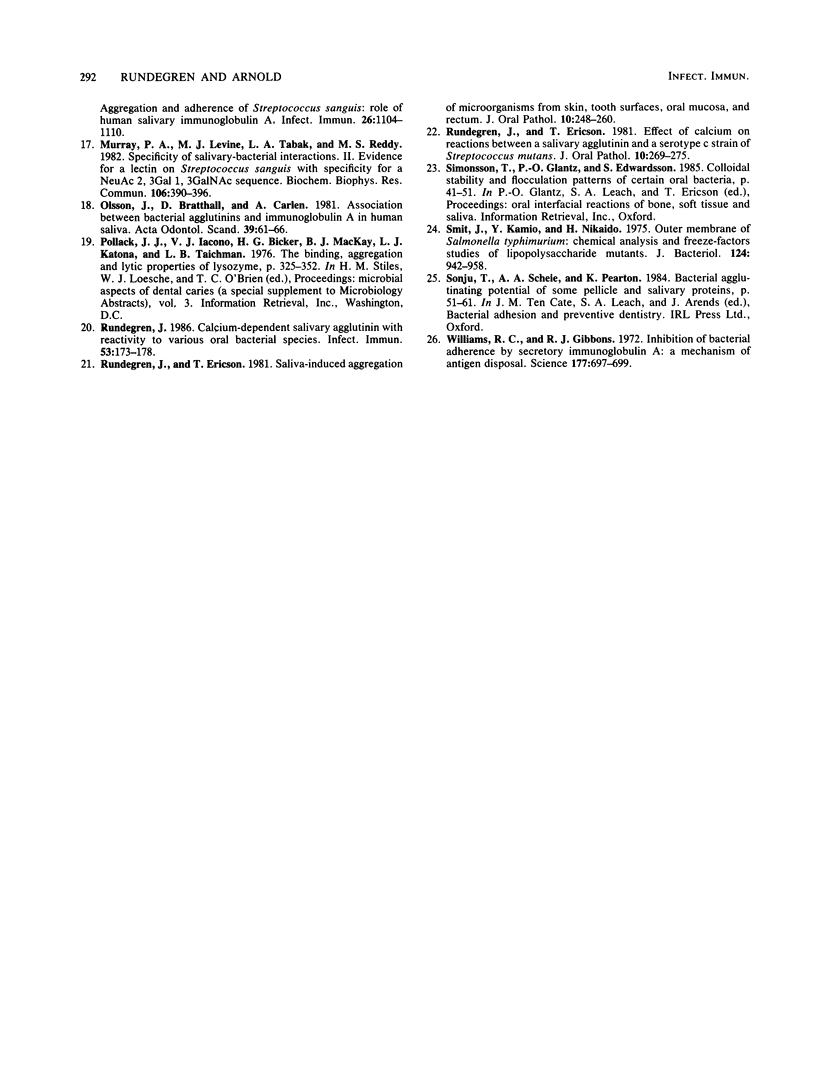Abstract
Previous studies have suggested that both secretory immunoglobulin A (sIgA) and various nonimmunoglobulin salivary glycoproteins are capable of agglutinating a variety of bacteria. The present study was designed to compare the nature of the agglutinins for Streptococcus mutans and Salmonella typhimurium in parotid saliva and colostrum. S. mutans was aggregated by saliva and colostrum, whereas S. typhimurium was aggregated only by saliva as detected by a spectrophotometric method. The principal salivary agglutinin for both S. mutans and S. typhimurium was calcium dependent and could be desorbed in phosphate-buffered saline (pH 6.8). In contrast, the colostral agglutinin was calcium independent and not readily desorbed. The agglutinin activities of saliva and colostrum for S. mutans were additive, suggesting independent target sites on the bacterial surface. The agglutinin activity of colostrum was totally associated with sIgA as was suggested by blocking of the agglutinating activity with anti-alpha-chain serum and the absence of blocking with an antibody specific for salivary agglutinin. Interestingly, anti-alpha-chain serum removed all agglutinating activity from saliva, but not from the phosphate-buffered saline-desorbed agglutinin. Dialysis of parotid saliva against 0.1 M disodium EDTA eliminated the agglutinin blocking activity of anti-alpha-chain serum but not that of the antiagglutinin antibody. The ability of anti-alpha-chain serum to block agglutination of the EDTA-dialyzed saliva could be restored by the addition of calcium chloride, suggesting that sIgA and salivary agglutinin are associated through a calcium-mediated interaction. These results indicate that bacterial agglutinating activity of colostrum, as detected spectrophotometrically, is mediated by sIgA, and that of saliva is mainly dependent upon a calcium-dependent nonimmunoglobulin agglutinin. The agglutinating activities of sIgA and parotid agglutinin seem to be additive, and their calcium-dependent association may favor the enhancement of their respective activities.
Full text
PDF




Selected References
These references are in PubMed. This may not be the complete list of references from this article.
- Arnold R. R., Mestecky J., McGhee J. R. Naturally occurring secretory immunoglobulin A antibodies to Streptococcus mutans in human colostrum and saliva. Infect Immun. 1976 Aug;14(2):355–362. doi: 10.1128/iai.14.2.355-362.1976. [DOI] [PMC free article] [PubMed] [Google Scholar]
- Babu J. P., Beachey E. H., Hasty D. L., Simpson W. A. Isolation and characterization of a 60-kilodalton salivary glycoprotein with agglutinating activity against strains of Streptococcus mutans. Infect Immun. 1986 Feb;51(2):405–413. doi: 10.1128/iai.51.2.405-413.1986. [DOI] [PMC free article] [PubMed] [Google Scholar]
- Babu J. P., Simpson W. A., Courtney H. S., Beachey E. H. Interaction of human plasma fibronectin with cariogenic and non-cariogenic oral streptococci. Infect Immun. 1983 Jul;41(1):162–168. doi: 10.1128/iai.41.1.162-168.1983. [DOI] [PMC free article] [PubMed] [Google Scholar]
- Bennick A., Kells D., Madapallimattam G. Interaction of calcium ions and salivary acidic proline-rich proteins with hydroxyapatite. A possible aspect of inhibition of hydroxyapatite formation. Biochem J. 1983 Jul 1;213(1):11–20. doi: 10.1042/bj2130011. [DOI] [PMC free article] [PubMed] [Google Scholar]
- Bläckberg L., Hernell O. Isolation of lactoferrin from human whey by a single chromatographic step. FEBS Lett. 1980 Jan 14;109(2):180–183. doi: 10.1016/0014-5793(80)81081-7. [DOI] [PubMed] [Google Scholar]
- Eggert F. M. The nature of secretory agglutinins and aggregating factors. IV. Complexing between non-mucin glycoproteins, immunoglobulins and mucins in human saliva and amniotic fluid. Int Arch Allergy Appl Immunol. 1980;62(1):46–58. [PubMed] [Google Scholar]
- Ericson T., Pruitt K., Wedel H. The reaction of salivary substances with bacteria. J Oral Pathol. 1975 Dec;4(6):307–323. doi: 10.1111/j.1600-0714.1975.tb01748.x. [DOI] [PubMed] [Google Scholar]
- Ericson T., Rundegren J. Characterization of a salivary agglutinin reacting with a serotype c strain of Streptococcus mutans. Eur J Biochem. 1983 Jun 15;133(2):255–261. doi: 10.1111/j.1432-1033.1983.tb07456.x. [DOI] [PubMed] [Google Scholar]
- Gibbons R. J., Qureshi J. V. Selective binding of blood group-reactive salivary mucins by Streptococcus mutans and other oral organisms. Infect Immun. 1978 Dec;22(3):665–671. doi: 10.1128/iai.22.3.665-671.1978. [DOI] [PMC free article] [PubMed] [Google Scholar]
- Hay D. I., Smith D. J., Schluckebier S. K., Moreno E. C. Relationship between concentration of human salivary statherin and inhibition of calcium phosphate precipitation in stimulated human parotid saliva. J Dent Res. 1984 Jun;63(6):857–863. doi: 10.1177/00220345840630060901. [DOI] [PubMed] [Google Scholar]
- Hogg S. D., Embery G. The isolation and partial characterization of a sulphated glycoprotein from human whole saliva which aggregates strains of Streptococcus sanguis but not Streptococcus mutans. Arch Oral Biol. 1979;24(10-11):791–797. doi: 10.1016/0003-9969(79)90040-2. [DOI] [PubMed] [Google Scholar]
- Kashket S., Hankin S. R. Interaction of streptococcal aggregating factors with thiol-and disulphide-reactive compounds. Arch Oral Biol. 1977;22(1):49–53. doi: 10.1016/0003-9969(77)90139-x. [DOI] [PubMed] [Google Scholar]
- Murray P. A., Levine M. J., Tabak L. A., Reddy M. S. Specificity of salivary-bacterial interactions: II. Evidence for a lectin on Streptococcus sanguis with specificity for a NeuAc alpha 2, 3Ga1 beta 1, 3Ga1NAc sequence. Biochem Biophys Res Commun. 1982 May 31;106(2):390–396. doi: 10.1016/0006-291x(82)91122-6. [DOI] [PubMed] [Google Scholar]
- Olsson J., Bratthall D., Carlén A. Association between bacterial agglutinins and immunoglobulin A in human saliva. Acta Odontol Scand. 1981;39(2):61–66. doi: 10.3109/00016358109162260. [DOI] [PubMed] [Google Scholar]
- Rundegren J. Calcium-dependent salivary agglutinin with reactivity to various oral bacterial species. Infect Immun. 1986 Jul;53(1):173–178. doi: 10.1128/iai.53.1.173-178.1986. [DOI] [PMC free article] [PubMed] [Google Scholar]
- Rundegren J., Ericson T. Effect of calcium on reactions between a salivary agglutinin and a serotype c strain of Streptococcus mutans. J Oral Pathol. 1981 Aug;10(4):269–275. doi: 10.1111/j.1600-0714.1981.tb01273.x. [DOI] [PubMed] [Google Scholar]
- Rundegren J., Ericson T. Saliva-induced aggregation of micro-organisms from skin, tooth surfaces, oral mucosa, and rectum. J Oral Pathol. 1981 Aug;10(4):248–260. doi: 10.1111/j.1600-0714.1981.tb01271.x. [DOI] [PubMed] [Google Scholar]
- Smit J., Kamio Y., Nikaido H. Outer membrane of Salmonella typhimurium: chemical analysis and freeze-fracture studies with lipopolysaccharide mutants. J Bacteriol. 1975 Nov;124(2):942–958. doi: 10.1128/jb.124.2.942-958.1975. [DOI] [PMC free article] [PubMed] [Google Scholar]
- Williams R. C., Gibbons R. J. Inhibition of bacterial adherence by secretory immunoglobulin A: a mechanism of antigen disposal. Science. 1972 Aug 25;177(4050):697–699. doi: 10.1126/science.177.4050.697. [DOI] [PubMed] [Google Scholar]


